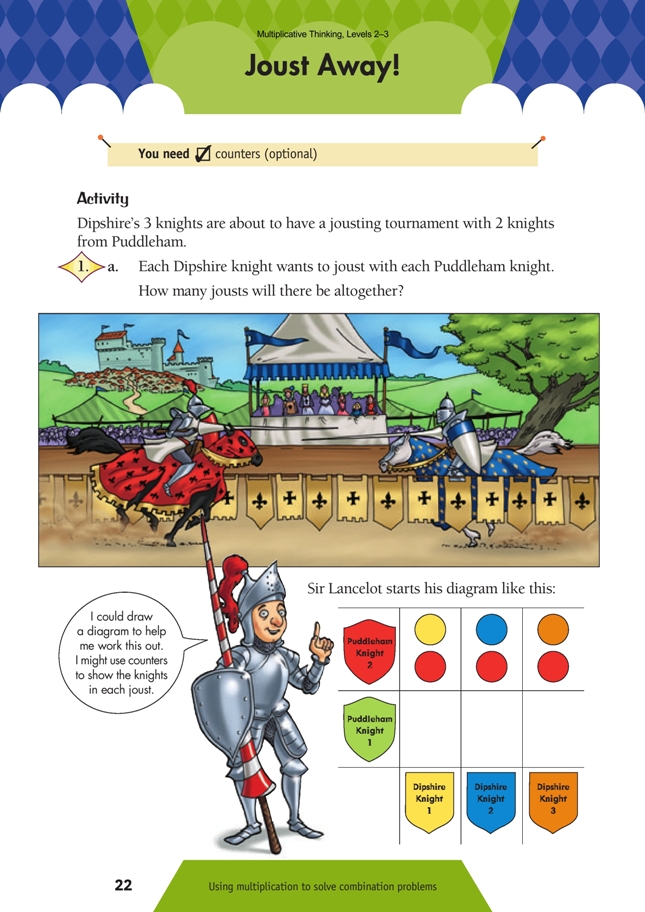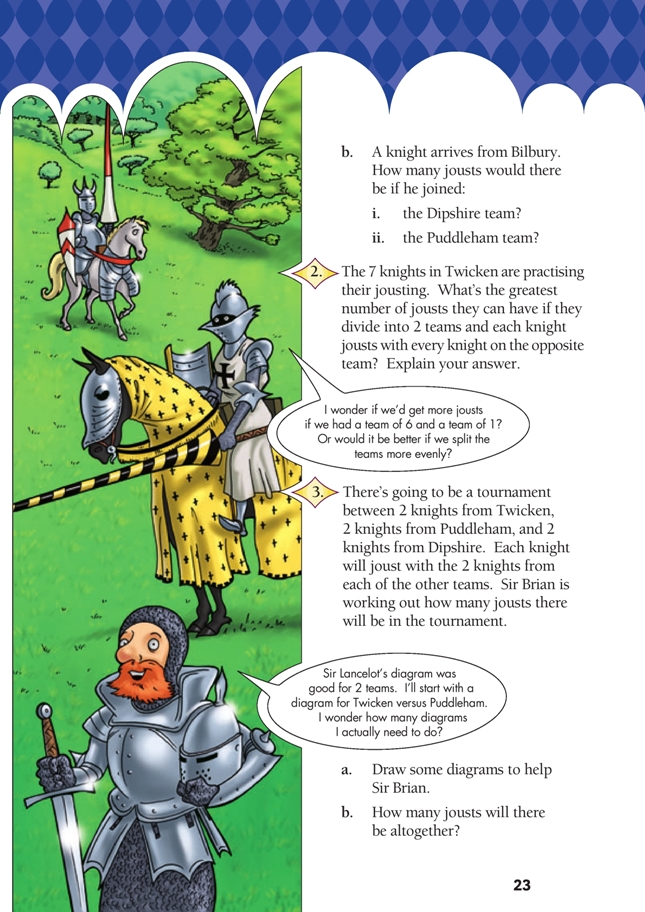This is a level 3 number activity from the Figure It Out series. It relates to Stage 6 of the Number Framework.
A PDF of the student activity is included.
Click on the image to enlarge it. Click again to close. Download PDF (817 KB)
use multiplication facts to solve problems
use diagrams or tables to solve problems
Number Framework Links
This activity is suitable for encouraging students at stages 5 and 6 to use multiplicative rather than additive thinking. Students at stage 4 could use the page in a guided instruction group, but they may not recognise the problem structure as multiplication.
FIO, Levels 2-3, Multiplicative Thinking, Joust Away, pages 22-23
Counters (optional)
This activity represents another situation in which multiplication is the means of working out the problem, but the structure of the problem differs from the common equal-groups structure. Combination problems can be a difficult presentation of multiplication, so while the calculations in this activity are within students’ basic facts range, the structure they are embedded in might make it hard for them to recognise this.
It is very important that students are exposed to a variety of problems that embody different structures so that they develop a fully robust understanding of the power of multiplication. Equal groups problems can readily be solved by repeated addition, but problems such as the ones in this activity require a different sort of thinking. There are not obvious groups to be repeated. In this structure, two factors are combined to form a set of pairs. The number of pairs is the solution to the problem. They are also known as Cartesian product problems and are thought to be the most difficult for students to understand. (Students need to know the concept to do this activity, but
they do not need to worry about the terminology.)
A motivating way to introduce these pages would be with model knights and horses (or you could use chess pieces: the black and white knights could represent two different teams, and the black and white horses could represent two more teams). These could be used to “act out” the jousts, emphasising to the students the pairings of knights required in the tournament.
One way to start the activity is to pose the question in 1a without the students looking at the actual page that it is on and, in particular, without looking at the diagram that relates to this question. This will enable you to see how the students might approach the problem. Ask the students to keep a systematic record of their answers. Then you can look at the diagram on the page and discuss how it works: How does it help us to find the answer?
As the students move to question 1b, ask them to predict what they think the effect of the knight from Bilbury will be. They may think it will be the same whichever team he joins. Use the diagram or other recording format to explore the answer.
Question 2 is a difficult problem. Students could work in pairs to provide an opportunity for support and discussion. Ask the students to present their answer to the group or class using diagrams or other means that show why their solution is correct. Trial and error may be the most common strategy for solving this. Look for students who recognise the multiplicative structure and employ known facts.
Question 3 adds another level to the problem: there are jousts between knights, but there are also groups of jousts between different pairings of teams. The prompt for students suggests using diagrams to help solve the problem. There is a lot of problem solving and thinking to be done here. Encourage the students to record and share their thinking.
These problems could be extended by making up different-sized jousting teams or different numbers of counties competing in a big tournament. Modern contexts such as tennis tournaments or interschool sports could also be used to provide further practice with this concept.
Answers to Problems
1. a. 6. (Each Dipshire knight has 2 jousts. 3 x 2 = 6)
b. i. 8. (2 Puddleham knights x 4 knights in Dipshire team is 2 x 4 = 8 jousts.)
ii. 9. (3 knights in Puddleham team x 3 Dipshire knights is 3 x 3 = 9 jousts.)
2. The greatest number of jousts possible is by splitting into a team of 3 and a team of 4: 3 knights x 4 knights is 12 jousts. Other options are 1 knight x 6 knights (6 jousts) or 2 knights x 5 knights (10 jousts).
3. a. Based on Sir Lancelot’s diagram, you could Page 24: Hydroslides have 3 or 2 diagrams.
As 3 diagrams:
b. There will be 12 jousts altogether. 2 teams of 2 is 2 x 2 = 4 jousts; each of those 4
knights has to joust with 2 more knights as well:
4 x 2 = 8; 4 + 8 = 12 jousts.


